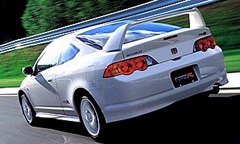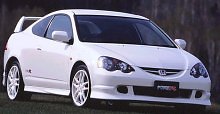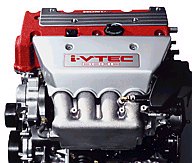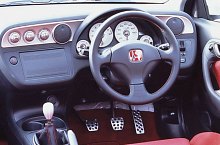Integra
Type R
 Not
many people know that this Integra is the forth generation (do you
remember
the first generation was a 5-door family hatch?). Yet fewer people know
that there were 2 generations of Type R appeared before this one. It
doesn't
matter, because it was the 2nd generation that successfully established
the reputation of Type R and since then changed the way people look at
Honda. Without the success of Integra Type R, we might not see Civic
and
Accord Type R, and probably S2000 as well. Not
many people know that this Integra is the forth generation (do you
remember
the first generation was a 5-door family hatch?). Yet fewer people know
that there were 2 generations of Type R appeared before this one. It
doesn't
matter, because it was the 2nd generation that successfully established
the reputation of Type R and since then changed the way people look at
Honda. Without the success of Integra Type R, we might not see Civic
and
Accord Type R, and probably S2000 as well.
What separates
Type R from
regular models is racing treatment - higher compression engine, forged
pistons and lightweight con-rods, front and rear tower braces, stiffer
suspensions, extensive weight reduction, sports seats ... all Type R
are
made and tuned in human intensive way so that production no. is
limited.
However, the
latest generation
seems to break this mold - though neither Honda nor any car magazines
mention
- by becoming more popular. Evidence one: the i-VTEC engine involves
less
human work (we'll see that later); evidence two: it appears in the
great
USA market in the name of Acura RSX Type S, thus you can expect big
sales
no. You may argue that the Type S has less power and lack of some
goodies,
but they are highly similar.
Design
 I
love the previous Integra's styling very much. Compare with the latest
one, it was cleaner and purer. The new one, styled in the USA, is
fatter,
tauter, undoubtedly more aggressive but also shows a lot of premature
styling
clues and rough edges, such as the odd headlamps and V-shape grille,
the
whole front air dam and side skirts. It looks no more original than any
tuner's cars. I
love the previous Integra's styling very much. Compare with the latest
one, it was cleaner and purer. The new one, styled in the USA, is
fatter,
tauter, undoubtedly more aggressive but also shows a lot of premature
styling
clues and rough edges, such as the odd headlamps and V-shape grille,
the
whole front air dam and side skirts. It looks no more original than any
tuner's cars.
Luckily, the
interior is
another matter. Although being neither the prettiest nor the most
long-lasting,
the new dashboard with alloy-effect panel is much more attractive and
better
made than the old one, which was barely functional. Driving position is
higher along with shoulder lines but there is also more headroom,
thanks
to the increase of height from 1330 to 1385mm. The rear seats are still
reserved for small children, but the adoption of Civic's
central-tunnel-less
floorpan does help freeing some foot room.
Chassis
Yes, the Integra
is based
on the new Civic platform, using the same suspensions with MacPherson
struts
up front and a double-wishbones-based multi-link setup at the rear.
That
means bye-bye to the all-double wishbones era. Whether this influence
the
superb handling will be seen later in this article. Of course, for a
2+2
coupe, it does not need the concert-hall-like rear seat accommodation
that
characterized the Civic, so the wheelbase is shortened. Compare with
the
old Integra Type R, it grows just a little bit - 5mm longer, 30mm wider
and 55mm taller. It even rides on the same 2570mm wheelbase.
In terms of
chassis rigidity,
the new R is in another league. It gains an astonishing 116% static
torsional
rigidity over the old car. That, accompany with better build quality,
would
have resulted in a lot of extra kilograms. Therefore Honda constructs
many
chassis components in aluminium alloy, such as front and rear tower
bars,
cross braces under floor, side impact beams, front bumper beam, front
suspension
lower arms etc. They even made the new engine and gearbox 10 and 2.5kg
lighter respectively. Good effort, but I don't quite understand why the
car still tip the scale at 1170kg (plus 10kg if loaded with air-con),
in
other words, 90kg heavier than the last generation. This should largely
cancel the extra power from the new 2-litre engine.
Engine
Honda's B18C
engine - which
powered the previous Type R - was famous for explosive power and
revability
without sacrificing too much drivability (unlike B16C). However, after
more than 10 years of evolution it finally came to an end and is
replaced
by a new 2.0-litre four, engine code K20C.
 K20C
is not developed exclusively for Integra Type R. It is a derivative of
the mass production K20A which started serving Stream MPV recently. No
matter K20A or K20C, they differ from the old B18 by three main
improvements:
1) increasing displacement from 1797 to 1998c.c.; 2) using roller
rockers
to reduce friction at valvetrain; 3) in addition to the existing
2-stage,
cam-changing VTEC, they gain a cam-phasing variable valve timing (VTC)
mechanism at intake camshaft like many manufacturers do. Honda calls
this
combination of VTEC and VTC as i-VTEC, where i stands for intelligent
(think
of iMac or iPaq, or VVT-i ?). See it this way, the conventional VTC
varies
the intake valve timing continuously and smoothly throughout the whole
rev range, so it flattens torque curve, which used to be the biggest
weakness
of VTEC. The VTEC, on the other hand, switch from "slow-timing,
low-lift"
cam lobes to "fast-timing, high-lift" cam lobes at around 6,000 rpm,
optimizing
ultimate power. K20C
is not developed exclusively for Integra Type R. It is a derivative of
the mass production K20A which started serving Stream MPV recently. No
matter K20A or K20C, they differ from the old B18 by three main
improvements:
1) increasing displacement from 1797 to 1998c.c.; 2) using roller
rockers
to reduce friction at valvetrain; 3) in addition to the existing
2-stage,
cam-changing VTEC, they gain a cam-phasing variable valve timing (VTC)
mechanism at intake camshaft like many manufacturers do. Honda calls
this
combination of VTEC and VTC as i-VTEC, where i stands for intelligent
(think
of iMac or iPaq, or VVT-i ?). See it this way, the conventional VTC
varies
the intake valve timing continuously and smoothly throughout the whole
rev range, so it flattens torque curve, which used to be the biggest
weakness
of VTEC. The VTEC, on the other hand, switch from "slow-timing,
low-lift"
cam lobes to "fast-timing, high-lift" cam lobes at around 6,000 rpm,
optimizing
ultimate power.
This sounds
fabulous, but
by no means in Type R territory because every Stream and regular
Integra
has them. What make the Type R producing some 60 more horsepower are:
1)
with VTEC at both intake and exhaust camshaft instead of just intake
side;
2) 11.5:1 compression ratio instead of 9.8:1; 3) straight and large
intake
port and manifold (but devoid of two-stage variable manifold as found
in
the lesser models); 4) two-stage variable back-pressure muffler; 5)
lighter
weight moving components such as high-strength con-rods, forged
crankshaft
and lightweight flywheel; 6) piston skirt added with lower friction
coating.
As a result,
maximum power
becomes 220hp (JIS) at 8,000rpm, up from the previous 200hp at the same
rev. Although not as astonishing as the 250hp (also JIS) S2000, the
i-VTEC
engine is cheaper (shares a lot of components with the mass production
version) while being more user friendly, in other words, more torquey
at
low to mid rev. Peak torque is 152 lbft at 7,000 rpm, equaling the
S2000
but occurs 500 rpm earlier. Although this cannot match the old Type R's
6,200 rpm, at any time the new engine deliver stronger torque,
especially
below 3000rpm, and is more linear.
Honda did not say
a word
about some traditional Type R goodies such as forged connecting rods,
forged
and polished pistons etc, letting us believing that the new engine is
designed
for higher production no. and lower cost. This coincide with the fact
that
the new engine is no more revvy than the old B18C although it has
bigger
bore and shorter stroke - the new combustion chamber is pure square,
with
both bore and stroke at 86mm compare with the old engine's 75mm bore
and
90mm stroke. In terms of power per litre, the i-VTEC is also no more
than
the old VTEC.
Anyway, as long
as the engine
is more powerful, more user-friendly yet being 10kg lighter, why should
we bother about racing treatment or not ?
Performance
The Type R can do
0-60 in
around 6 seconds flat, which matches the likes of Nissan Silvia turbo
and
Fiat Coupe turbo. However, the way to exploit its performance is very
different
from those turbocharged rivals. It is best to use the whole rev-range
by
working closely with your best companion - the new, close-ratio 6-speed
gearbox, whose short-throw shift is slick and light.
The high-revving
character
of i-VTEC engine still plays the most important role in Type R's
entertainment.
Like the old B18C, once the needle past 3,000 rpm, torque slides back a
bit and bottoms at 4,000, from then it rises slowly until the second
phase
VTEC changeover at 6,000, then it becomes really exciting, revving
strongly
towards the 8,400 rpm red-line accompany with additive exhaust roar.
Admittedly,
the second phase does not come as explosive as the B18C, which may
disappoint
some VTEC hardcore.
In return, you
get much more
torque. At low rev, where the old Type R suffers, the new engine
remains
lively and tractable, this makes the car easier to live with in daily
basis.
Handling
With a 116%
stiffer chassis,
wider tracks, 17-inch 215 tyres, quicker steering rack, Helical LSD and
4-pot Brembo front brakes, we expect a lot of improvement here. On
super-smooth
race tracks, it does impress us by lapping 1 or 2 seconds quicker, by
showing
higher cornering speed and stability, by displaying more predictable
rear
end movement. However, on public roads, especially the bumpy ones, it
handles
actually worse than before.
 First
to be noticed is the increase of understeer, which makes it not as
agile
and adjustable mid-corner. Where the old Type R drivers can floor down
the throttle to swing the car out of corner, the new car has too much
understeer
to fight with. The rear end is particularly difficult to slide even
with
heavy provoke. Someone tried to explain that by pointing out the car
has
more weight at front, but in fact I found the new car's 61:39 front to
rear distribution is actually 1 point better than before, so it seems
that
suspension setting is the one to be blamed. First
to be noticed is the increase of understeer, which makes it not as
agile
and adjustable mid-corner. Where the old Type R drivers can floor down
the throttle to swing the car out of corner, the new car has too much
understeer
to fight with. The rear end is particularly difficult to slide even
with
heavy provoke. Someone tried to explain that by pointing out the car
has
more weight at front, but in fact I found the new car's 61:39 front to
rear distribution is actually 1 point better than before, so it seems
that
suspension setting is the one to be blamed.
We should notice
that the
new Integra has struts replacing double wishbones up front, the former
might work brilliant enough in the family hatch Civic but has been
never
applied to the super-hot Integra Type R. MacPherson strut, if use in
front-drive
cars, is also famous of torque steer, that coincides with the second
flaw
of the Integra - too much torque steer. No one complained the old
Integra
about that, not only because of superior suspensions but also because
its
1.8-litre engine did not have sufficient torque to upset the steering.
The new engine only makes things worse.
Admittedly, the
torque steer
is not severe and is usually predictable, but what really upset keen
drivers
is the unpredictable bump steer. On any surfaces other than
super-smooth,
the steering is always nervous, letting surface irregularities
deviating
steering feedback and effort. This make judgement hard to be made. Once
again, such weakness is due to the inherent flaw of the new Civic
platform.
The steering rack is mounted high on the firewall to save space and
free
up cabin room, but it also leads to a geometry easy to be influenced by
bumps.
The only areas
improved are:
1) marginally smoother ride (but still very stiff); 2) powerful braking.
In short, the new
Type R
is more difficult to handle and no where as controllable or as fun to
drive
as its predecessor. The slower, softer-tuned regular Integra might be
another
matter, but the Type R does not match the high standard its predecessor
set. Honda pays the price here for going mainstream.
|